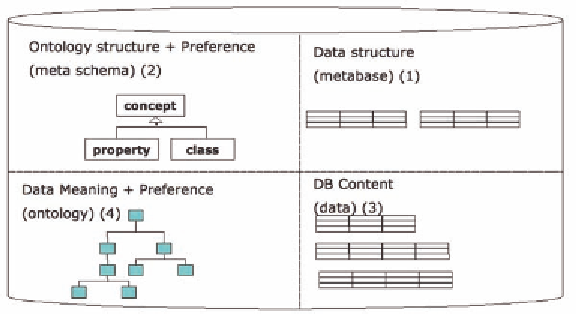Database Reference
In-Depth Information
Figure 1. The OntoDB Four Parts architecture
including OWL, DAML+OIL (McGuinness et
al., 2002) and PLIB.
OntoDB initially supports the PLIB ontol-
ogy model.
•
The
meta-schema
part (2)
. The meta-
schema part records the model of the on-
tology used into a reflexive meta-model.
For the ontology part, the meta schema
part plays the same role as the one played
by the meta-base in traditional databases
systems.
The Different Components of OntoDB
OntoDB ensures the persistence of both models
and their instances. A dedicated language, On-
toQL, has been implemented in order to manipulate
and query the different components of the OntoDB
system. The OntoDB architecture is composed of
four parts described in Figure 1. These components
are briefly summarised as follows.
The OntoQL Language for OntoDB
The OntoQL language has been designed to exploit
the power offered by the OntoDB architecture
(Jean et al., 2005; Jean et al., 2006). Indeed, On-
toQL is able to access and manipulate the model,
its instances and the meta-model.
OntoQL can deal both with the entities of
an ontology and their instances. Moreover, the
language supports the manipulation of the model
that describes the ontology (e.g.#class, #property,
#datatype). It is equipped with a data definition
language DDL (CREATE and ALTER clauses), a
data manipulation language (INSERT, UPDATE
and DELETE clauses) and a query facility lan-
guage (SELECT clause). Syntactical details of
the language are given in the Table2.
Let us for instance consider the tourism domain.
An ontology for this domain manipulates entities
•
The
meta-base
part (1)
. The meta-base,
also often called
catalog system
, is a tra-
ditional part of any database. It contains
system tables used to manage all the data
contained in the database. In OntoDB, it
contains specifically the description of all
the tables and columns defined in the three
other parts of the architecture.
•
The
data
part (3)
. It represents the objects
of domain described by the entities (class-
es and properties) provided by an ontology.
These objects are represented following
the table per class approach.
•
The
ontology
part (4)
. It contains all the
ontologies that define the semantics of the
various domains covered by the database.

Search WWH ::

Custom Search